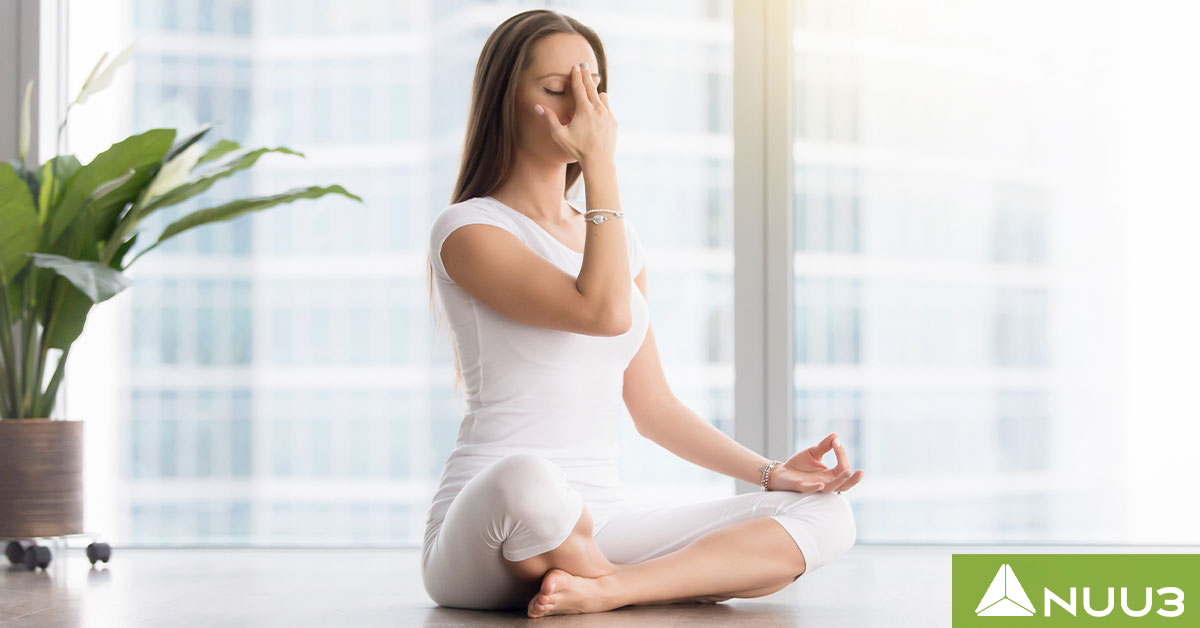All You Need to Know About Yoga Breathing

Overview
Yoga has become increasingly popular worldwide. In the United States alone, the number of people who practice yoga at least once a year has increased from 21 million in 2016 to 34.4 million[1] in 2021, which is an astounding 63.8% increase. To get the most from yoga practice, proper breathing is crucial. Therefore, this post aims to provide more information on yoga breathing and its amazing benefits. Keep reading to discover more about breathing yoga and how to do it correctly.
What Does Yoga Breathing mean?
Yoga breathing is defined as conscious and controlled breathing that matches the rhythm of yoga postures. It is one of the eight pillars or philosophies of yoga. Besides breath control, pillars of yoga include yama (abstinences), niyama (observances), asana (yoga postures), pratyahara (withdrawal of the senses), Samadhi (absorption), dhyana (meditation), and dharana (concentration).
Although a part of yoga, yoga breathing exercises can be performed independently as well, thanks to their numerous benefits. Yoga teachers explain that breath is to yoga as water is to a fish – it is essential for movement and life force.
Since breathing is a natural function, we tend to overlook it and don’t pay that much attention to our inhales and exhales. But, focusing on breath yoga allows for a better connection of mind, body, and soul.
Why Does Breathing Matter in Yoga?
Breathing is one of the most important aspects of yoga because it is used as an object of meditation. When you’re practicing yoga and going from one pose to another, you focus on your breath to stay in the moment. Breathe yoga allows you to stay present and let go of everything that is stressing you out. With breathing exercises, it becomes easier to relax and get the most from the entire experience.
The role of breath in yoga is not only to ground you in the present moment but also to provide physical support to your postures. This is because proper breathwork enhances your endurance and enables you to hold challenging positions for a longer period than you normally would.
Yet another reason proper breathing is important in yoga is because it helps you achieve connection on physical, psychological, and spiritual levels. After all, that is the whole point of yoga – to connect every aspect of your being.
4 types of Yoga Breathing and Their Benefits
Breathing in yoga doesn’t involve just one specific technique that you do all the time. There are different types of yoga breathing exercises. They are described below.
1. Ujjayi pranayama (victorious breath or ocean breath)
Ujjayi pranayama is a type of yoga breathing that even beginners can easily perform. This technique is primarily used in support of yoga postures, especially vinyasa style (an approach to yoga where you move from one posture directly to the next one).
The greatest benefit of ujjayi pranayama is that it increases your oxygen consumption by up to 50%[2]. This provides extra power and focus to your performance. Additionally, it helps in calming the body’s fight-or-flight response and makes you more resilient to stress.
You can perform this breathing technique by inhaling deeply through your nose, slightly contracting the back of your throat, and exhaling through your nose. Keep in mind you shouldn’t feel tightness in your throat.
2. Nadi shodhana pranayama (alternate nostril breathing)
The main purpose of nadi shodhana pranayama is to unblock “nadis” i.e. the energy passages that carry vital life force energy throughout your body. This breathing technique promotes calmness. You can perform it with yoga postures or as a standalone exercise.
Benefits of this type of breath yoga include anxiety reduction and better overall well-being. You can perform this exercise whenever you want as long as you’re not sick and your nose isn’t congested. Alternate nostril breathing improves cardiovascular and lung function and stabilizes your heart rate.
To perform this exercise, you need to sit in a comfortable position with your legs crossed and place your left hand on your left knee. Then, lift your right hand toward your nose and exhale completely. Close the right nostril with the right thumb and start inhaling through the left nostril. Close the left nostril with your fingers, open the right nostril, and exhale. Then, inhale through your right nostril, close it, open the left nostril, and exhale. This is one cycle. You can repeat the process.
3. Kumbhaka pranayama (breath retention)
Breath retention is the central practice of yogic breathing. It can be divided into two types. One type is Antara or retention after inhale, and the second type is bahya or retention after exhale.
The benefits of retaining your breath for a short time include stress reduction and improved relaxation.You can perform this exercise by sitting on the floor with your legs crossed, making sure your back is straight. Then, you inhale through your nose for 5 seconds, hold the air inside for 10 seconds, and exhale slowly through your mouth.
4. Kapalabhati pranayama (breath of fire)
This is an energizing breathing exercise that clears your nasal passages, lungs, and your mind at the same time. The breath of fire brings clarity and lightness to the frontal region of your brain. Other benefits of this technique include better circulation, improved alertness, improved memory and concentration, a balanced nervous system, and stronger immunity.
Sit on the floor with your legs crossed making sure your back is straight and proceed to inhale through your nose to the count of 5. Feel the stomach rising by placing your hand on the abdominal area. Exhale forcefully through your nose engaging muscles of your core. Ideally, inhales and exhales should have the same length.
What are the benefits of yoga breathing?
Yoga breathing has a multitude of benefits and some of them are listed below:
-
Relieves stress and anxiety: evidence confirms[3] that yogic breathing can reduce anxiety and depression. It is an easy and effective way to relieve stress and tackle situations that make you anxious. Proper breathing activates the parasympathetic nervous system and produces calmness and tranquility.
-
Improves sleep: practicing breathe yoga before bedtime can reduce activation of the sympathetic nervous system, thus promoting better sleep quality and duration. Since you’re stress-free, it becomes easier to fall asleep.
-
Promotes relaxation: proper breathwork stimulates the vagus nerve[4] thus promoting a state of relaxation by lowering heart rate, decreasing muscle tension, and calming your mind. Yogic breathing calms your mind just like Nuu3 Keep Calm Gummies, which reduce stress, anxiety, and physical tension.
-
Lowers blood pressure: yogic breathing improves circulation and reduces strain on the cardiovascular system thereby lowering blood pressure[5]. That’s why it improves cardiovascular health too.
-
Improves executive functions: oxygen-rich blood from focused breathing enhances cognitive functions such as problem-solving, decision-making, and attention thus improving mental clarity.
-
Helps manage addiction: breathe yoga increases self-awareness and emotional regulation. It gives people with addiction a coping mechanism to manage and curb their cravings and addictive behaviors more effectively. One study found[6] that breathwork therapy can be an adjunct treatment for people with opioid addiction.
-
Increases energy: thanks to increased oxygen intake, the body’s cells and tissues get much-needed nutrients, which results in energy levels. Supplements like Nuu3 Apple Cider Vinegar Gummies can also boost your energy and promote overall health.
-
Boosts immunity: studies confirm[7] that yogic breathing exhibits a positive effect on immune function. This could happen because proper breathing strengthens the body’s defenses. Combine yogic breathing with Nuu3 Nature’s Super Greens to enhance immune response, fight oxidative stress, and improve gut health.
Main rules for proper yoga breathing
Practicing yoga breathing isn’t that difficult, but there’s a lot you can do to get the most from these exercises. If you’ve never practiced yogic breathing before, these five golden rules will help you master this practice easily.
1. Inhale when opening the front of the body
It is crucial to sync your breath and movement. By inhaling when opening the front of the body, you maximize oxygen intake. Moreover, you also create space for deeper breaths. As a result, you enhance the effectiveness of your breathing and gain more endurance to hold a certain position.
2. Exhale while compressing the front of the body
In breath yoga, exhaling while compressing the front of your body deepens the stretch and releases the tension. This is particularly important in positions such as forward folds or twists. By exhaling while compressing the front of your body, you promote better alignment and allow for a more complete expulsion of stale air from your lungs.
3. If the breath is suspended after inhalation, don’t move
In yoga breathing exercises, it’s usually necessary to take deep breaths so that your chest and abdomen expand. Once you inhale fully, your body will resist further movement naturally. That’s why it’s important to suspend the breath after inhalation, not while you’re moving. Pausing without movement allows for better oxygen absorption, and promotes mindfulness.
4. Only move during breath suspension if it’s following an exhalation
Exhalation in breath yoga is just as important as inhaling. You can prolong the effects of exhalation by momentarily suspending your breath. That happens because your body isn’t resistant to the movement when your lungs and stomach are relaxed after you exhale. Doing so allows for smoother transitions between postures.
5. Breathe deeply and effortlessly
Cultivation of deep, diaphragmatic breath is central to yoga breathing exercises. For that reason, you need to prioritize ease of breathing. As a result, you can avoid unnecessary tension and foster a sense of relaxation since breathing deeply and effortlessly optimizes oxygen exchange.
How to teach yourself yogic breathing
Breathing is a natural function that we perform constantly without even thinking about it. Although there are many breath yoga instructors and trainers who can teach you about breathing, you can also learn on your own. To do this, you need to pay attention to every breath you take. We usually don’t pay attention to our breathing since it’s something we do automatically. However, by focusing on every inhale and exhale, you can improve your breathing practice and enhance its benefits.
Always keep in mind that practice makes perfect. The more you practice yogic breathing, the easier it will be to properly execute every technique.
How should I breathe during yoga?
During a yoga practice, it's important to focus on deep and diaphragmatic breathing. This means inhaling fully, feeling your abdomen expand, and then exhaling to empty your lungs. It's also recommended that you coordinate your breath with movement, to enhance relaxation and concentration. Maintaining a steady and rhythmic breathing pattern can be very helpful in achieving these goals.
Should I breathe through my nose?
You should breathe through your nose in yoga. Nasal breathing optimizes oxygen uptake in yoga and stimulates the parasympathetic nervous system to promote relaxation. Both inhalation and exhalation should go through your nose.
FAQs
What is yoga breathing called?
Yoga breathing is called pranayama (“prana” means “life force” whereas “ayama” means “stretching”), and it encompasses various techniques to regulate the breath to enhance physical, mental, and spiritual well-being. Proper breathing is an integral aspect of yoga and mastering correct breathing techniques can enhance the benefits of yoga.
What is the most important thing when starting yoga?
The most important thing when starting yoga is consistency. When it comes to yoga, practice makes perfect. Ideally, you should create a routine and do yoga regularly. That way, practicing yoga becomes a habit that improves the quality of life. Also, make sure to practice proper breathing and do it consistently as well.
How long are yoga breaths?
The duration of yoga breaths may depend on your capacity and the specific technique you practice. In most cases, you need to hold the air inside your lungs for 10 seconds before exhaling.
Outlook
Yoga breathing is just as important as perfecting different poses. There are several types of yogic breathing, and you can learn them on your own or consult a professional. Make sure to practice regularly, and you’ll notice significant improvements in your physical and mental health and well-being.
References
1] ↑ https://www.statista.com/statistics/191625/participants-in-yoga-in-the-us-since-2008/
2] ↑ https://pubmed.ncbi.nlm.nih.gov/1794892/
3] ↑ https://www.ncbi.nlm.nih.gov/pmc/articles/PMC6329222/
4] ↑ https://www.ncbi.nlm.nih.gov/pmc/articles/PMC6189422/
5] ↑ https://www.ncbi.nlm.nih.gov/pmc/articles/PMC10765252/
6] ↑ https://www.ncbi.nlm.nih.gov/pmc/articles/PMC4479894/
7] ↑ https://www.ncbi.nlm.nih.gov/pmc/articles/PMC3573542/












